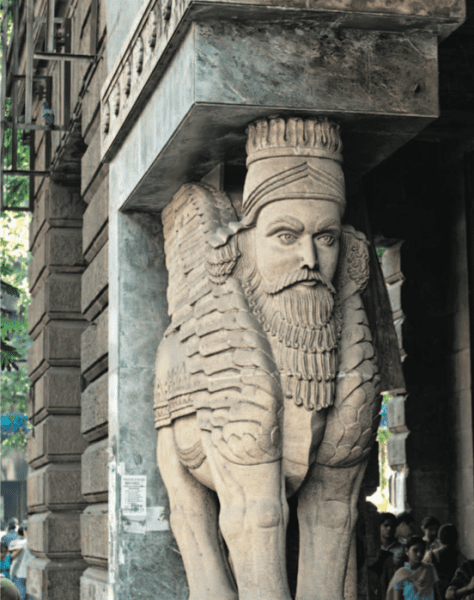Living Truth – The Parsis
Introduction
The Parsis are a minuscule community of Persian descent, living mainly in India with a well-knit Diaspora in Pakistan, UK, USA, New Zealand and Australia. Their fellow believers still live in Kerman, Yazd, and Shiraz in contemporary Iran. Considered a kindred people to the early Hindus who knew them since antiquity as Parsikas (the Rig Veda also mentions them), the Parsis also contributed to the makings of Judaism, Northern Buddhism, Christianity, and Islam.
In fact, it was even once felt that Buddha borrowed more than what is known from Persian philosophy. Recent research has shown that the messianic ideas of Judaism were learned at the imperial Persian courts of the Achaemenian Empire (550 BCE – 330 BCE), that Christian ideas have their origins in the Parsi faith and the Greek philosophers had their apprentice in Iran.
Interestingly, it is not merely their ancient roots and their impact on the evolution of religions and philosophies that distinguish these people, but also their role in the molding of modern times. Their contribution, for example, to the making of India as we know it today.
Dadabhai Naoroji, Pherozeshah Mehta, Jamshedji Tata, Madam Cama, Shapourji Saklatwalla, B.M. Malbari, J.R.D. Tata, Homi Bhabha and others stand out. Others beyond our shores like Zubin Mehta and Freddy Mercury have shone bright.
The Parsis are known as the descendents of not only Jamshid (whom Indians know as Yama), the prophet Zarathushtra (literally the “Herald of the Golden Dawn”), but also Cyrus the Great, the founder of a united Iran (and celebrated as a prophet by the Jews, Christians and Muslims), as also Darius and Khusrau Anoshirwan.
A more careful understanding of their culture will also acknowledge the epic poets of Iran: Firdausi, Rumi and Sa’adi as the continuation of this tradition. One must also remember that Behzadi, or Salman Farsi, as history would remember him, one of the close companions of Mohammed – the prophet of Islam, was a Parsi.
Another figure that appears in the history of the Parsis, is Meherji Rana, who versed the Mughal emperor Akbar in the precepts of the Parsi faith, and as Parsi folklore goes, bestowed the holy sadra and kusti on the monarch.
Despite the fact that the Parsis, both in the times of antiquity and modernity, were, and are, a well-known people, it is felt that not much space is given to the understanding of their philosophy. Despite the Greeks mentioning the name of Zarathushtra, or Zoroaster, as the Greeks and the Romans knew him (astrothutes “the star priest” or “the star diviner” derived from the Greek word astron or aster implying star), it was only the great German philosopher G.W.F. Hegel who, in his Introduction to the Lectures on the History of Philosophy, granted the space for Persian thinking as one of the pioneering moments in world philosophy, followed by Friedrich Nietzsche, who in his magnum opuses Thus Spake Zarathustra and Ecce Homo called onto the world to recognize that it is not Western Reason that serves as the foundation for a thinking and humane world, but the Persian world of authentic wisdom.
One thousand five hundred years before the Greeks invented the word “philosophy” as the discourse of the “love of wisdom”, the Persians celebrated wisdom in their passion for Ahura Mazda. Mazda, one must note, is wisdom, and Ahura Mazda is God, or literally “the Lord of Wisdom”.
No one is sure how a people who were masters of a great part of the civilised world could be reduced to minority status. It must be noted that it is not only the geographical space of contemporary Iran which was a part of the original Iran of antiquity (Airyanem Vaejah, or “the Aryan Expanse”, later Iran Vej), but the Iran of the Parsis also had as its essential parts: Afghanistan, Turkmenistan, Azerbaijan, Tajikistan and Armenia, not to forget that even Egypt and Jerusalem were parts of the Parsi Empires.
A good example is that of the legendary Sam Manekshaw. It is said that when he led the Indian Army to a rout of the Pakistani forces in what was then called East Bengal (now Bangladesh), he ordered that the Pakistani prisoners of war be treated with dignity—they were given a copy of the Muslim holy book, the Koran; and the same prisoners were told to sleep on beds whilst the Indian soldiers who were guarding them were told to sleep on the ground.
It is said that a deep sense of fairness prevails in all Parsis as also the sense for social justice. Now the roots of the sense of fairness as well as the dynamic unity of faith and citizenship go back to antiquity, based on their philosophy of seeking wisdom (Mazda) with the good mind (Vohu Manah) combined with the political character of multiculturalism and the philosophy of religious tolerance institutionalised by the Parsi monarch Cyrus in 550 BCE.
“To understand this culture of the Parsis one must understand the teachings of their prophet.”
Here one again recalls Nietzsche, who had said about the Persian prophet, that he was: “more truthful than any other thinker. His teaching”, so Nietzsche continued, “and his alone, upholds truthfulness as the supreme virtue—that is to say, the opposite of the cowardice of the ‘idealist’, who takes flight in the face of reality; Zarathustra has more courage in him than all the thinkers put together.
To tell the truth and to shoot well with arrows: that is the Persian virtue”. To speak the truth and to shoot well with arrows (even metaphoric ones) is a virtue that the followers of the ancient Persian sage—the Parsis—follow even today. It would not be exaggerated to claim that speaking the truth is fundamental for the Parsis.
As far back as in the 5th century BCE, the Greek historian, Herodotus, noted that the most disgraceful thing (for the Persians) in the world was to tell a lie. The holy book of the Parsis—the Avesta—also mentions how evil came into the world, only when the first lie was spoken.
One of the first features that one observes in the Parsis Is their insistence on the truth. Since they understand that the conflict between good and evil is the driving force of all existence, they interpret goodness as righteousness, honesty and labour; as opposed to the evil force of what they call Agra Mainyu (literally the “Force of Regression”, popularly translated as the “Evil Spirit”).
This Force of Regression is in constant conflict with Spenta Mainyu. Spenta Mainyu as the “Progressive Force”, also translated as the “Holy Spirit”, implies the economy of abundance. It also signifies the production of wealth and its just distribution.
On the other hand, evil in the form of Agra Mainyu, Means economic scarcity, starvation, sickness and death. The fact that the Parsis are an affluent people lies in the understanding of this theme of progression and regression. That is why it is felt that the Parsis naturally strive for success in the world, both for the betterment of themselves as well as for society at large.
Every Parsi is said to know these basic principles of their ancient faith. Good thoughts, good words and good deeds form the leitmotiv of these people. Quite often the Parsi faith is called “the philosophy of action”. They are compelled to action. Spenta Mainyu compels them to do so.
Festivals
Their festivals are symbolic expressions of their philosophy. Goodness is also marked by unbridled optimism and merry making. Laughter stands at the centre of the Parsi culture. After all—as reminded by Pliny and the Middle Persian books—Zarathushtra was born laughing.
The holy days of the Parsis are Navroze (“New Years Day”) which usually falls on 21st March, but also celebrated in August (because of different calendars), Pateti (“Day of Confession”) which is the last day of the Parsi new year, Sadeh (100) a winter festival celebrated a hundred days after the first day of winter, Zarathust-No-Diso (“The Death Anniversary of Zarathushtra”), and Khordad-Sal (“The Birthday of Zarathushtra”).
Navjote, their initiation ceremony, is marked by a child being invested with a sadra (holy shirt) and kusti (thread).
Surprising facts
It is ironical, that despite being a persecuted faith, the Parsis bear no grudge against anyone. Since laughter and merry making are central to this community, they also place food as a very important part of their life.
Many of the Parsi restaurants in Mumbai were started by Iranian Zoroastrian refugees who, despite being illiterate and poor, took to hard labour and then started restaurants.
Yum, who would like some Parsi food?
Like Parsi culture in general, which is a synthesis of the Persian, Indian and European cultures, the food of the Parsis also includes the combination of these three styles. Typical Parsi dishes are Pulao Dal and Sali ma Chicken along with the Lagan nu Custard (bread and milk baked custard served at Parsi weddings) but the most famous being Dhansak, along with mava cakes and khari biscuits.
Writer: Murzban Jal
Photographs © Hemant Patil
Illustration: Harshavardhan Kadam
Copy Editor: Ankita Badoni, Kshitija Pande








 +91 942 358 5984
+91 942 358 5984